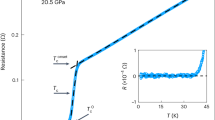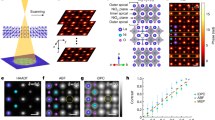Abstract
THE crystal structures of the light actinides have intrigued physicists and chemists for several decades1. Simple metals and transition metals have close-packed, high-symmetry structures, such as body-centred cubic, face-centred cubic and hexagonal close packing. In contrast, the structures of the light actinides are very loosely packed and of low symmetry—tetragonal, orthorhombic and monoclinic. To understand these differences, we have performed total-energy calculations, as a function of volume, for both high-and low-symmetry structures of a simple metal (aluminium), a non-magnetic transition metal (niobium), a ferromagnetic transition metal (iron) and a light actinide (uranium). We find that the crystal structure of all of these metals is determined by the balance between electrostatic (Madelung) interactions, which favour high symmetry, and a Peierls distortion of the crystal lattice, which favours low symmetry. We show that simple metals and transition metals can adopt low-symmetry structures on expansion of the lattice; and we predict that, conversely, the light actinides will undergo transitions to structures of higher symmetry on compression.
This is a preview of subscription content, access via your institution
Access options
Subscribe to this journal
Receive 51 print issues and online access
$199.00 per year
only $3.90 per issue
Buy this article
- Purchase on Springer Link
- Instant access to full article PDF
Prices may be subject to local taxes which are calculated during checkout
Similar content being viewed by others
References
Katz, J. J., Seaborg, G. T. & Morss, L. R. (eds) The Chemistry of the Actinide Elements Vols 1 & 2 (Chapman & Hall, New York, 1986).
Harrison, W. A. Pseudopotentials in the Theory of Metals (Benjamin/Cummings, Menlo Park, California, 1966).
Friedel, J. in The Physics of Metals (ed. Ziman, J. M.) Ch. 8 (Cambridge Univ. Press, New York, 1969).
Skriver, H. L. Phys. Rev. B31, 1909–1923 (1985).
Duthie, J. C. & Pettifor, D. G. Phys. Rev. Lett. 38, 564–567 (1977).
Pettifor, D. G. J. chem. Phys. 69, 2930–2931 (1978).
Johansson, B. & Rosengren, A. Phys. Rev. B11, 2836–2857 (1975).
Skriver, H. L., Johansson, B. & Andersen, O. K. Phys. Rev. Lett. 41, 42–45 (1978).
Skriver, H. L., Johansson, B. & Andersen, O. K. Phys. Rev. Lett. 44, 1230–1233 (1980).
Moruzzi, V. L. & Marcus, P. M. Phys. Rev. B38, 1613–1620 (1988).
Brooks, M. S. S. & Johansson, B. J. Phys. F13, L197–202 (1983).
Wills, J. M. & Cooper, B. R. Phys. Rev. B36, 3809–3823 (1987).
Harrison, W. A. Electronic Structure and the Properties of Solids (Freeman, San Francisco, 1980).
Author information
Authors and Affiliations
Rights and permissions
About this article
Cite this article
Söderlind, P., Eriksson, O., Johansson, B. et al. A unified picture of the crystal structures of metals. Nature 374, 524–525 (1995). https://doi.org/10.1038/374524a0
Received:
Accepted:
Issue Date:
DOI: https://doi.org/10.1038/374524a0
This article is cited by
-
Static and dynamic evolution of CO adsorption on γ-U (1 0 0) surface with different levels of Mo doping using DFT and AIMD calculations
Nuclear Science and Techniques (2023)
-
Density functional theory study of adsorption of H2O on γ-U(110) surface
Indian Journal of Physics (2023)
-
Accelerated crystal structure prediction of multi-elements random alloy using expandable features
Scientific Reports (2021)
-
Density functional study of H2O molecule adsorption on α-U(001) surface
Journal of Molecular Modeling (2016)
-
Stability of a new cubic monoxide of Thorium under pressure
Scientific Reports (2015)
Comments
By submitting a comment you agree to abide by our Terms and Community Guidelines. If you find something abusive or that does not comply with our terms or guidelines please flag it as inappropriate.



